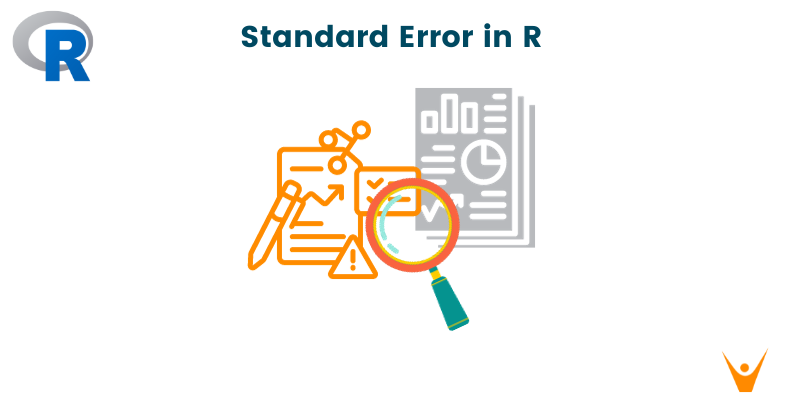In the field of statistics and data analysis, the concept of standard error plays an important role in quantifying the uncertainty associated with sample statistics. In R programming language, understanding the standard error is fundamental for making reliable inferences from data. In this blog, we will learn about the standard error in R, exploring its formula, its application in regression analysis, and how it can be used across groups.
Standard Error in R
Let's start by establishing a foundational understanding of standard error. The standard error is the approximate standard deviation of a statistical sample population. It describes the variation between the calculated mean of the population and one which is considered known, or accepted as accurate. It provides an estimate of how much the sample mean is likely to vary from the true population mean.
The standard error is calculated using the following formula.
SE = s / √n
Here, s is the sample standard deviation and n is the sample size.
This formula indicates that as the sample size increases, the standard error decreases, reflecting increased precision in estimating the population parameter.
Standard Error by Group in R
When working with grouped data in R, it is essential to compute the standard error for each group for group-wise comparison and insights. Two commonly used functions for this purpose are tapply() and aggregate().
Using tapply()
The tapply() function is useful for applying a function to subsets of a vector, split by one or more factors. We can use it to implement the standard error calculations to our data. Let's consider an example where we have a dataset named data with a numeric variable value and a categorical variable group.
set.seed(123) data <- data.frame( group = rep(c("A", "B", "C"), each = 10), value = rnorm(30) ) se_by_group <- tapply(data$value, data$group, function(x) sd(x) / sqrt(length(x)))
In this example, se_by_group will contain the standard error for each group in the dataset.
Using aggregate()
The aggregate function in R is another great way to apply calculations to groups. It can be used to calculate the standard error of the dataset by group. When working with datasets that contain several variables that need to be analyzed and aggregated based on particular categories, this function comes in handy.
se_by_group_agg <- aggregate(value ~ group, data = data, function(x) sd(x) / sqrt(length(x)))
Here, se_by_group_agg will be a data frame containing the standard error for each group
Standard Error in Regression
In regression analysis, the standard error takes on a slightly different role. It is associated with the regression coefficients and reflects the precision of the estimated coefficients. The standard error in the regression model is obtained from the summary() function applied to a linear model. The function, along with standard error gives us all the details about the linear model in question, which then helps us to understand better information about the models.
Let us look at an example of regression and standard error in regression using the R's built -n 'mtcars' dataset.
model <- lm(mpg ~ wt + hp, data = mtcars) se_regression <- summary(model)$coefficients[, "Std. Error"]
In this code example, the se_regression will have the standard errors that are associated with the coefficients of the linear regression model.
Understanding standard errors is essential for hypothesis testing and drawing inferences about population parameters. Standard errors play an important role in computing confidence intervals and conducting tests on regression coefficients while doing hypothesis testing. It provides a measure of the precision and reliability of estimates, aiding researchers and analysts in making informed decisions about the significance and reliability of observed effects or relationships in the data.
Aggregate Standard Error
When working with aggregated or grouped data, the calculation of standard errors across groups is important, when comparing means or regression coefficients among different groups. Standard errors provide valuable insights into the precision and reliability of group-specific estimates, enabling us to make informed comparisons and statistical analyses across various categories or subgroups within the data.
Using tapply() for Aggregated Standard Error
Building upon the previous example, if we say we want to calculate the aggregated standard error for each group in the data dataset, then this is how we will do it.
agg_se_by_group <- tapply(data$value, data$group, function(x) sd(x) / sqrt(length(x)))
Here, agg_se_by_group will provide the aggregated standard error for each group.
Using aggregate() for Aggregated Standard Error
Similar to tapply(), we can also apply the aggregate() function to calculate the aggregated standard error across groups.
agg_se_by_group_agg <- aggregate(value ~ group, data = data, function(x) sd(x) / sqrt(length(x)))
The agg_se_by_group_agg variable will be a data frame containing the aggregated standard error for each group.
In regression analysis, when handling grouped data, it becomes crucial to account for potential impacts on standard errors. Grouped data might display heteroscedasticity, violating the assumption of homoscedasticity in the regression analysis. In such situations, it's better to use alternatives such as clustered standard errors, which can provide more accurate and reliable results.
Conclusion
In this blog about the standard error in R, we've covered its basic formula, its application in group-wise analysis using tapply() and aggregate(), and its importance in regression analysis. A clear understanding of standard errors is crucial for making informed statistical conclusions. R offers powerful tools for these calculations. Whether you're working with basic descriptive statistics, group-wise comparisons, or regression analysis, integrating the concept of standard error enriches the reliability and depth of statistical analyses.








